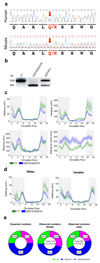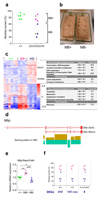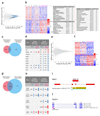TDP-43 gains function due to perturbed autoregulation in a Tardbp knock-in mouse model of ALS-FTD
- PMID: 29556029
- PMCID: PMC5884423
- DOI: 10.1038/s41593-018-0113-5
TDP-43 gains function due to perturbed autoregulation in a Tardbp knock-in mouse model of ALS-FTD
Erratum in
-
Publisher Correction: TDP-43 gains function due to perturbed autoregulation in a Tardbp knock-in mouse model of ALS-FTD.Nat Neurosci. 2018 Aug;21(8):1138. doi: 10.1038/s41593-018-0160-y. Nat Neurosci. 2018. PMID: 29872124
Abstract
Amyotrophic lateral sclerosis-frontotemporal dementia (ALS-FTD) constitutes a devastating disease spectrum characterized by 43-kDa TAR DNA-binding protein (TDP-43) pathology. Understanding how TDP-43 contributes to neurodegeneration will help direct therapeutic efforts. Here we have created a TDP-43 knock-in mouse with a human-equivalent mutation in the endogenous mouse Tardbp gene. TDP-43Q331K mice demonstrate cognitive dysfunction and a paucity of parvalbumin interneurons. Critically, TDP-43 autoregulation is perturbed, leading to a gain of TDP-43 function and altered splicing of Mapt, another pivotal dementia-associated gene. Furthermore, a new approach to stratify transcriptomic data by phenotype in differentially affected mutant mice revealed 471 changes linked with improved behavior. These changes included downregulation of two known modifiers of neurodegeneration, Atxn2 and Arid4a, and upregulation of myelination and translation genes. With one base change in murine Tardbp, this study identifies TDP-43 misregulation as a pathogenic mechanism that may underpin ALS-FTD and exploits phenotypic heterogeneity to yield candidate suppressors of neurodegenerative disease.
Conflict of interest statement
The authors declare no competing financial interests
Figures








References
-
- Neumann M, et al. Ubiquitinated TDP-43 in frontotemporal lobar degeneration and amyotrophic lateral sclerosis. Science. 2006;314:130–133. - PubMed
-
- Arai T, et al. TDP-43 is a component of ubiquitin-positive tau-negative inclusions in fronto temporal lobar degeneration and amyotrophic lateral sclerosis. Biochemical and biophysical research communications. 2006;351:602–611. - PubMed
Publication types
MeSH terms
Substances
Supplementary concepts
Grants and funding
- S10 OD016366/OD/NIH HHS/United States
- SITRAN/APR13/983-797/MNDA_/Motor Neurone Disease Association/United Kingdom
- MR/K010611/1/MRC_/Medical Research Council/United Kingdom
- R01 NS088689/NS/NINDS NIH HHS/United States
- R01 NS065847/NS/NINDS NIH HHS/United States
- SITRAN/JUL16/987-797/MNDA_/Motor Neurone Disease Association/United Kingdom
- MR/L003813/1/MRC_/Medical Research Council/United Kingdom
- NC/N001451/1/NC3RS_/National Centre for the Replacement, Refinement and Reduction of Animals in Research/United Kingdom
- R01 FD004127/FD/FDA HHS/United States
- SREEDHARAN/JAN13/943-795/MNDA_/Motor Neurone Disease Association/United Kingdom
- SREEDHARAN/APR16/849-791/MNDA_/Motor Neurone Disease Association/United Kingdom
- R01 NS073873/NS/NINDS NIH HHS/United States
- RIBCHESTER/APR15/838-791/MNDA_/Motor Neurone Disease Association/United Kingdom
LinkOut - more resources
Full Text Sources
Other Literature Sources
Medical
Molecular Biology Databases
Research Materials
Miscellaneous

